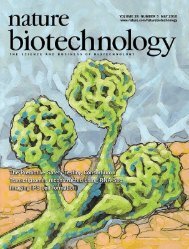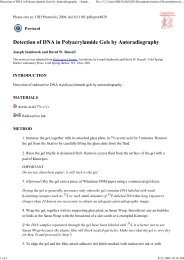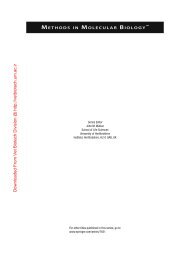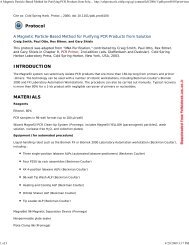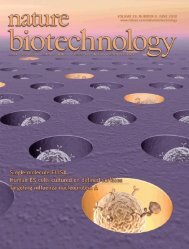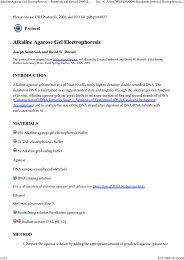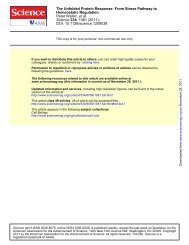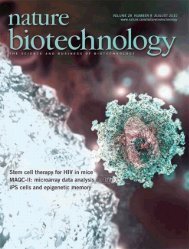correspondence© 2010 Nature America, Inc. All rights reserved.systems. Examples include the possibilityof a resurgence in oil price from $30/bblrecently (as of December 2008; http://tonto.eia.doe.gov/dnav/pet/hist/rwtcd.htm) back to and beyond the previoushigh of $147/bbl (July 2008) in the nearfuture (modeled here as $100 per barrelin both cases), the introduction of morestringent CO 2 emissions targets andcarbon trading schemes (potentiallyrising to ~$200 per ton CO 2 by 2050; refs.7,8) and the increased demand for foodand fuel by a population rising from 6.8billion in 2009 to 9.4 billion in 2050 (refs.9,10). All of these factors appear to bestrong drivers for the economic viabilityof this technology. This analysis suggeststhat although microalgal biofuel systemsremain in an early stage of development,they are now approaching profitability ifthe co-production systems in the base case,and/or the increased productivities in theprojected case can be attained. A recentreport by Huntley and Redalje 11 estimatesthat current technology could produceoil for $84/bbl (with no value attributedto the non-oil fraction), with reasonableadvancements in technology reducing thiscost to $50/bbl or less. This supports ourconclusion that co-production is requiredin the short term and that at increased oilprices (that is, $100 in this model) an IRRof 15% could be obtained.Considerable synergies also exist betweenmicroalgae biofuel production and a widerange of other industries, including humanand animal food production, veterinaryapplications, agrochemicals, seed suppliers,biotech, water treatment, coal seam gas,material supplies and <strong>engineering</strong>, fuelrefiners and distributors, bio-polymers,pharmaceutical and cosmetic industries,as well as coal-fired power stations (CO 2capture) and transport industries, such asaviation. Sound opportunities therefore existfor the development of a rapidly expandingsustainable industry base whose productivityis independent of soil fertility and lessdependent on water purity. Thus, thesetechnologies can conceivably be scaled tosupply a substantial fraction of oil demandwithout increasing pressure on waterresources while potentially contributingto food production. Furthermore, as thisstudy was conservatively modeled onpublished data, excluding subsidies (whichare actually commonly used to developother renewable energy sectors, for example,photovoltaics) and proprietary technologies,it follows that strategic partnerships andgovernment policy decisions will play a largepart in facilitating a coordinated scale-upand deployment of these technologies tocontribute to future energy security.Note: Supplementary information is available on theNature Biotechnology website.ACKNOWLEDGMENTSThe authors gratefully acknowledge the support ofthe Australian Research Council, IMBcom, and theeconomic advice of Liam Wagner.COMPETING INTERESTS STATEMENTThe authors declare competing financial interests:details accompany the full-text HTML version of thepaper at http://www.nature.com/naturebiotechnology/.Evan Stephens 1 , Ian L Ross 1 , Zachary King 2 ,Jan H Mussgnug 3 , Olaf Kruse 3 , Clemens Posten 4 ,Michael A Borowitzka 5 & Ben Hankamer 11 The University of Queensland, Institute forMolecular Bioscience, St. Lucia, Queensland,Australia. 2 IMBcom, St. Lucia, Queensland,Australia. 3 University of Bielefeld, Department ofBiology, AlgaeBioTech Group, Bielefeld, Germany.4 University of Karlsruhe, Institute of Life ScienceEngineering, Bioprocess Engineering, Karlsruhe,<strong>Ontology</strong> <strong>engineering</strong>To the Editor:Gene <strong>Ontology</strong> (GO) 1 and similarbiomedical ontologies are critical tools oftoday’s genetic research. These ontologiesare crafted through a painstaking process ofmanual editing, and their organization relieson the intuition of human curators. Herewe describe a method that uses informationtheory to automatically organize thestructure of GO and optimize thedistribution of the information within it. Weused this approach to analyze the evolutionof GO, and we identified several areas wherethe information was suboptimally organized.We optimized the structure of GO andused it to analyze 10,117 gene expressionsignatures. The use of this new versionchanged the functional interpretations of97.5% (P < 10 –3 ) of the signatures by, onaverage, 14.6%. As a result of this analysis,several changes will be introduced in thenext releases of GO. We expect that theseformal methods will become the standard toengineer biomedical ontologies.Every year, over 400,000 new articlesenter the biomedical literature 2 , creating anunprecedented corpus of knowledge that isimpossible to explore with traditional meansof literature consultation. This situationmotivated the development of biomedicalontologies, structured informationGermany. 5 Murdoch University, School ofBiological Sciences and Biotechnology, Algae R&DCenter, Murdoch, Western Australia, Australia.e-mail: b.hankamer@imb.uq.edu.au1. Waltz, E. Nat. Biotechnol. 27, 15–18 (2009).2. Mascarelli, A. Nature 461, 460–461 (2009).3. Melis, A. Plant Sci. 177, 272–280 (2009).4. Weissman, J.C. & Goebel, R.P. Design and Analysis ofPond Systems for the Purpose of Producing Fuels (SolarEnergy Research Institute, Golden, Colorado, SERI/STR-231–2840, 1987).5. Benemann, J.R. & Oswald, W.J. Systems and EconomicAnalysis of Microalgae Ponds for Conversion of CO 2to Biomass. Final Report to the Pittsburgh EnergyTechnology Center. Grant no. DE-FG22–93PC93204(1996).6. Huggett, B. Nat. Biotechnol. 26, 1208–1209 (2008).7. McFarland, J.R., Reilly, J.M. & Herzog, H.J. EnergyEcon. 26, 685–707 (2004).8. Zhu, Z., Graham, P., Reedman, L. & Lo, T.A. Decis. Econ.Finance 32, 35–48 (2009).9. Anonymous. World Population Data Sheet (PopulationReference Bureau, Washington, DC, 2009). 10. Anonymous. Soziale und Demographische Daten zurWeltbevölkerung (Deutsche Stiftung Weltbevölkerung,Hannover, Germany, 2009). 11. Huntley, M.E. & Redalje, D.G. Mitig. Adapt. StrategiesGlob. Change 12, 573–608 (2007).repositories that organize biomedicalfindings into hierarchical structures andcontrolled vocabularies. GO is arguably themost successful example of a biomedicalontology. GO is a controlled vocabulary todescribe gene and gene product attributesin any organism and includes 26,514 termsorganized along three dimensions: molecularfunction, biological process and cellularcomponent. GO has become even moreintensively used with the introduction ofhigh-throughput genomic platforms becauseof its ability to categorize large amounts ofinformation using a controlled vocabulary togroup objects and their relationships 1,3,4 .Today, GO and other biomedicalontologies are the result of a painstaking,costly and slow process of manual curationthat requires reaching a consensus amongmany experts to implement a change.Furthermore, the topology of GO hasbecome critically important because ofthe introduction of gene set enrichmentmethods. These methods have allowedinvestigators to characterize the results ofa high-throughput experiment in termsof coherent, knowledge-defined sets ofgenes (e.g., pathways, functional classesor chromosomal locations) rather thanin terms of anecdotal evidence about128 volume 28 number 2 february 2010 nature biotechnology
correspondence© 2010 Nature America, Inc. All rights reserved.systems. Examples include the possibilityof a resurgence in oil price from $30/bblrecently (as of December 2008; http://tonto.eia.doe.gov/dnav/pet/hist/rwtcd.htm) back to and beyond the previoushigh of $147/bbl (July 2008) in the nearfuture (modeled here as $100 per barrelin both cases), the introduction of morestringent CO 2 emissions targets andcarbon trading schemes (potentiallyrising to ~$200 per ton CO 2 by 2050; refs.7,8) and the increased demand for foodand fuel by a population rising from 6.8billion in 2009 to 9.4 billion in 2050 (refs.9,10). All of these factors appear to bestrong drivers for the economic viabilityof this technology. This analysis suggeststhat although microalgal biofuel systemsremain in an early stage of development,they are now approaching profitability ifthe co-production systems in the base case,and/or the increased productivities in theprojected case can be attained. A recentreport by Huntley and Redalje 11 estimatesthat current technology could produceoil for $84/bbl (with no value attributedto the non-oil fraction), with reasonableadvancements in technology reducing thiscost to $50/bbl or less. This supports ourconclusion that co-production is requiredin the short term and that at increased oilprices (that is, $100 in this model) an IRRof 15% could be obtained.Considerable synergies also exist betweenmicroalgae biofuel production and a widerange of other industries, including humanand animal food production, veterinaryapplications, agrochemicals, seed suppliers,biotech, water treatment, coal seam gas,material supplies and <strong>engineering</strong>, fuelrefiners and distributors, bio-polymers,pharmaceutical and cosmetic industries,as well as coal-fired power stations (CO 2capture) and transport industries, such asaviation. Sound opportunities therefore existfor the development of a rapidly expandingsustainable industry base whose productivityis independent of soil fertility and lessdependent on water purity. Thus, thesetechnologies can conceivably be scaled tosupply a substantial fraction of oil demandwithout increasing pressure on waterresources while potentially contributingto food production. Furthermore, as thisstudy was conservatively modeled onpublished data, excluding subsidies (whichare actually commonly used to developother renewable energy sectors, for example,photovoltaics) and proprietary technologies,it follows that strategic partnerships andgovernment policy decisions will play a largepart in facilitating a coordinated scale-upand deployment of these technologies tocontribute to future energy security.Note: Supplementary information is available on theNature Biotechnology website.ACKNOWLEDGMENTSThe authors gratefully acknowledge the support ofthe Australian Research Council, IMBcom, and theeconomic advice of Liam Wagner.COMPETING INTERESTS STATEMENTThe authors declare competing financial interests:details accompany the full-text HTML version of thepaper at http://www.nature.com/naturebiotechnology/.Evan Stephens 1 , Ian L Ross 1 , Zachary King 2 ,Jan H Mussgnug 3 , Olaf Kruse 3 , Clemens Posten 4 ,Michael A Borowitzka 5 & Ben Hankamer 11 The University of Queensland, Institute forMolecular Bioscience, St. Lucia, Queensland,Australia. 2 IMBcom, St. Lucia, Queensland,Australia. 3 University of Bielefeld, Department ofBiology, AlgaeBioTech Group, Bielefeld, Germany.4 University of Karlsruhe, Institute of Life ScienceEngineering, Bioprocess Engineering, Karlsruhe,<strong>Ontology</strong> <strong>engineering</strong>To the Editor:Gene <strong>Ontology</strong> (GO) 1 and similarbiomedical ontologies are critical tools oftoday’s genetic research. These ontologiesare crafted through a painstaking process ofmanual editing, and their organization relieson the intuition of human curators. Herewe describe a method that uses informationtheory to automatically organize thestructure of GO and optimize thedistribution of the information within it. Weused this approach to analyze the evolutionof GO, and we identified several areas wherethe information was suboptimally organized.We optimized the structure of GO andused it to analyze 10,117 gene expressionsignatures. The use of this new versionchanged the functional interpretations of97.5% (P < 10 –3 ) of the signatures by, onaverage, 14.6%. As a result of this analysis,several changes will be introduced in thenext releases of GO. We expect that theseformal methods will become the standard toengineer biomedical ontologies.Every year, over 400,000 new articlesenter the biomedical literature 2 , creating anunprecedented corpus of knowledge that isimpossible to explore with traditional meansof literature consultation. This situationmotivated the development of biomedicalontologies, structured informationGermany. 5 Murdoch University, School ofBiological Sciences and Biotechnology, Algae R&DCenter, Murdoch, Western Australia, Australia.e-mail: b.hankamer@imb.uq.edu.au1. Waltz, E. Nat. Biotechnol. 27, 15–18 (2009).2. Mascarelli, A. Nature 461, 460–461 (2009).3. Melis, A. Plant Sci. 177, 272–280 (2009).4. Weissman, J.C. & Goebel, R.P. Design and Analysis ofPond Systems for the Purpose of Producing Fuels (SolarEnergy Research Institute, Golden, Colorado, SERI/STR-231–2840, 1987).5. Benemann, J.R. & Oswald, W.J. Systems and EconomicAnalysis of Microalgae Ponds for Conversion of CO 2to Biomass. Final Report to the Pittsburgh EnergyTechnology Center. Grant no. DE-FG22–93PC93204(1996).6. Huggett, B. Nat. Biotechnol. 26, 1208–1209 (2008).7. McFarland, J.R., Reilly, J.M. & Herzog, H.J. EnergyEcon. 26, 685–707 (2004).8. Zhu, Z., Graham, P., Reedman, L. & Lo, T.A. Decis. Econ.Finance 32, 35–48 (2009).9. Anonymous. World Population Data Sheet (PopulationReference Bureau, Washington, DC, 2009). 10. Anonymous. Soziale und Demographische Daten zurWeltbevölkerung (Deutsche Stiftung Weltbevölkerung,Hannover, Germany, 2009). 11. Huntley, M.E. & Redalje, D.G. Mitig. Adapt. StrategiesGlob. Change 12, 573–608 (2007).repositories that organize biomedicalfindings into hierarchical structures andcontrolled vocabularies. GO is arguably themost successful example of a biomedicalontology. GO is a controlled vocabulary todescribe gene and gene product attributesin any organism and includes 26,514 termsorganized along three dimensions: molecularfunction, biological process and cellularcomponent. GO has become even moreintensively used with the introduction ofhigh-throughput genomic platforms becauseof its ability to categorize large amounts ofinformation using a controlled vocabulary togroup objects and their relationships 1,3,4 .Today, GO and other biomedicalontologies are the result of a painstaking,costly and slow process of manual curationthat requires reaching a consensus amongmany experts to implement a change.Furthermore, the topology of GO hasbecome critically important because ofthe introduction of gene set enrichmentmethods. These methods have allowedinvestigators to characterize the results ofa high-throughput experiment in termsof coherent, knowledge-defined sets ofgenes (e.g., pathways, functional classesor chromosomal locations) rather thanin terms of anecdotal evidence about128 volume 28 number 2 february 2010 nature biotechnology
- Page 3 and 4: volume 28 number 2 february 2010COM
- Page 5 and 6: in this issue© 2010 Nature America
- Page 7 and 8: © 2010 Nature America, Inc. All ri
- Page 10 and 11: NEWS© 2010 Nature America, Inc. Al
- Page 12 and 13: NEWS© 2010 Nature America, Inc. Al
- Page 14 and 15: NEWS© 2010 Nature America, Inc. Al
- Page 16 and 17: © 2010 Nature America, Inc. All ri
- Page 18 and 19: © 2010 Nature America, Inc. All ri
- Page 20 and 21: © 2010 Nature America, Inc. All ri
- Page 22 and 23: NEWS feature© 2010 Nature America,
- Page 24 and 25: uilding a businessComing to termsDa
- Page 26 and 27: uilding a business© 2010 Nature Am
- Page 28 and 29: correspondence© 2010 Nature Americ
- Page 30 and 31: correspondence© 2010 Nature Americ
- Page 34 and 35: correspondence© 2010 Nature Americ
- Page 36 and 37: case studyNever againcommentaryChri
- Page 38 and 39: COMMENTARY© 2010 Nature America, I
- Page 40 and 41: COMMENTARY© 2010 Nature America, I
- Page 42 and 43: patents© 2010 Nature America, Inc.
- Page 44 and 45: patents© 2010 Nature America, Inc.
- Page 46 and 47: news and viewsChIPs and regulatory
- Page 48 and 49: news and viewsFrom genomics to crop
- Page 50 and 51: news and views© 2010 Nature Americ
- Page 52 and 53: news and views© 2010 Nature Americ
- Page 54 and 55: e s o u r c eRational association o
- Page 56 and 57: e s o u r c e© 2010 Nature America
- Page 58 and 59: e s o u r c e© 2010 Nature America
- Page 60 and 61: e s o u r c e© 2010 Nature America
- Page 62 and 63: © 2010 Nature America, Inc. All ri
- Page 64 and 65: B r i e f c o m m u n i c at i o n
- Page 66 and 67: i e f c o m m u n i c at i o n sAUT
- Page 68 and 69: lettersa1.5 kb hVPrIntron 112.5 kbA
- Page 70 and 71: letters© 2010 Nature America, Inc.
- Page 72 and 73: letters© 2010 Nature America, Inc.
- Page 74 and 75: l e t t e r sReal-time imaging of h
- Page 76 and 77: l e t t e r sFigure 2 Time-lapse li
- Page 78 and 79: l e t t e r s© 2010 Nature America
- Page 80 and 81: l e t t e r sRational design of cat
- Page 82 and 83:
l e t t e r s© 2010 Nature America
- Page 84 and 85:
l e t t e r s© 2010 Nature America
- Page 86 and 87:
sample fluorescence was measured as
- Page 88 and 89:
careers and recruitmentFourth quart




